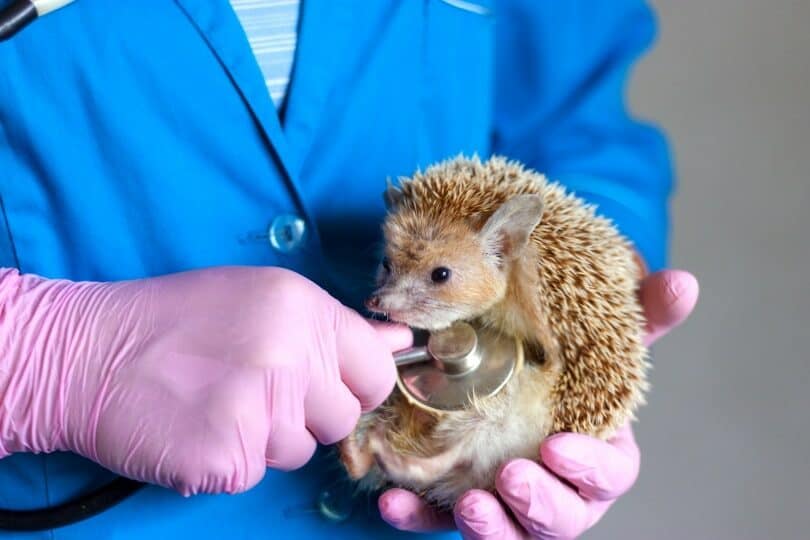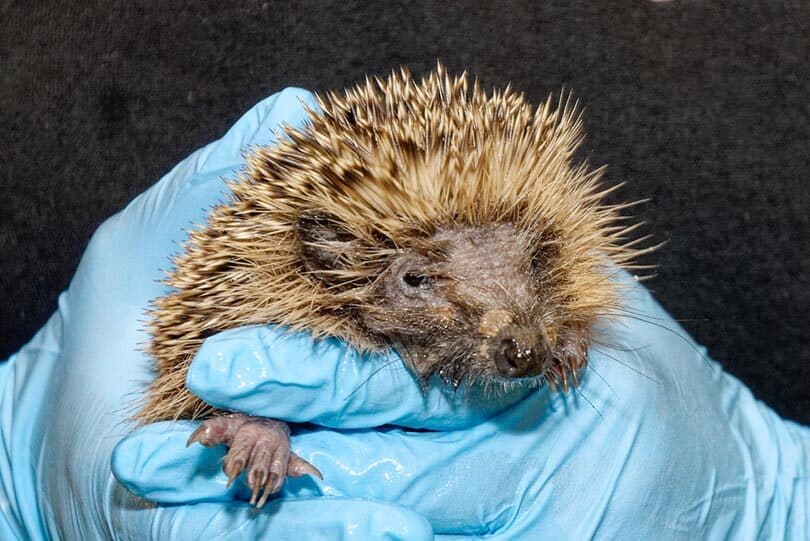Hedgehogs are undeniably cute. These unique and inquisitive creatures make wonderful pets for owners who are willing to put in the work to keep their prickly animals happy and healthy.
In order to make sure that your hedgehog is well looked after, you need to provide it with the right housing and environment, exercise, and the correct type and amount of food. Knowing the most common signs of disease is also important, as hedgehogs can develop a variety of illnesses.
Let’s take a look at the most common signs that may indicate that a hedgehog is sick and what these signs could possibly mean.
The 14 Signs Your Hedgehog Might Be Sick
1. Decreased or Absent Appetite
A decreased or absent appetite is seen with many different diseases and conditions. Often, one of the first signs that an animal is sick is a change in appetite. When a hedgehog starts eating less or stops eating altogether, it’s important to determine if the underlying cause is due to illness or something else. Stress from a change in environment can cause a hedgehog to stop eating. A change in food may also be to blame.
If nothing has changed in your hedgehog’s environment or if your hedgehog has stopped eating for a day or two, it’s important to get it checked by a vet as it could indicate that your hedgehog is sick. This is also true for a change in appetite accompanied by other signs of disease such as low energy levels.
Hedgehogs that have stopped eating for whatever reason, are at risk for developing a condition known as hepatic lipidosis, or fatty liver disease. Symptoms of fatty liver disease include low energy levels, diarrhea, jaundice (yellow discoloration of the skin, eyes, and gums), and neurological signs such as wobbling while walking, weakness, and coma. Hepatic lipidosis can be fatal if not treated promptly.
2. Weight Loss
There are many diseases that can cause a hedgehog to lose weight. Some of the more common conditions associated with weight loss include:
- An absent or reduced appetite due to illness
- An inability or reluctance to eat due to oral pain, caused by conditions such as disease and oral tumors
- Malabsorptive disorders that impair the body’s ability to absorb nutrients from the gut, seen in conditions such as cancer and heavy intestinal parasite burdens
- Neurological disease resulting in weakness or paralysis, for example, Wobbly Hedgehog Syndrome
- An increased caloric demand from infection, inflammation, and cancer
- Chronic diseases involving the major organs such as the heart
Changes in a hedgehog’s diet, environment, or stress levels, can also lead to weight loss. Weight loss is a sign that a hedgehog needs to be seen by a veterinarian.

3. Low Energy Levels
A hedgehog can become lethargic due to many different diseases. In addition to a reduced or absent appetite, lethargy is often one of the first signs that a hedgehog is unwell. If your hedgehog becomes lethargic, it should be seen by a veterinarian.
4. Diarrhea
Diarrhea can be caused by a variety of problems ranging from an incorrect diet to bacterial and parasitic infections.
A change in diet or feeding the incorrect foods, such as milk and bread, can cause a hedgehog to develop diarrhea. Bacterial infections as well as infections with intestinal parasites, such as worms and Protozoa, can also cause diarrhea.
Salmonella is the most common cause of bacterial gastrointestinal infections in hedgehogs. It’s important to be aware that Salmonella is a zoonosis. This means that the bacteria can be spread to humans. Any person handling and treating a hedgehog with diarrhea should take extra precautions to avoid catching this disease. Precautions include wearing gloves and disinfecting areas where the hedgehog has been. Children, elderly people, and people with weakened immune systems should also take care when handling hedgehogs.

5. Vomiting
Common causes of vomiting include gastrointestinal infections and gastrointestinal obstructions. When a hedgehog ingests foreign bodies such as carpet fibers, hair, and rubber, they may become lodged in the gut and cause an intestinal obstruction. This is a life-threatening situation.
- Interesting read: Celebrating Our Pets: From Companions to Heroes to the Unusual
6. Nasal Discharge and Sneezing
Nasal discharge and sneezing are common symptoms of both upper and lower respiratory tract infections. Bacteria that commonly cause pneumonia in hedgehogs include Bordetella, Pasteurella, and Corynebacterium.
Factors that may predispose a hedgehog to develop a respiratory tract infection include suboptimal environmental temperature, dusty or soiled bedding, poor nutrition, and reduced immune function.
In addition to a nasal discharge and sneezing, other signs of a respiratory tract infection include a reduced or absent appetite, respiratory noise, coughing, difficulty breathing, and low energy levels. A hedgehog showing any of these signs should be seen by a vet as a respiratory tract infection can be life-threatening.

7. Difficulty Breathing
As mentioned above, difficulty breathing can be a sign that a hedgehog is suffering from a respiratory tract infection.
Heart disease can also cause a hedgehog to develop breathing difficulties. The most common form of heart disease in hedgehogs is dilated cardiomyopathy. Dilated cardiomyopathy is a condition where the chambers of the heart become enlarged and lose their ability to contract. As a result, the heart’s ability to pump blood to the rest of the body is decreased. Signs of dilated cardiomyopathy include difficulty breathing, decreased activity, weight loss, and a swollen abdomen. Unfortunately, some hedgehogs with this disease will die before showing signs.
Affected hedgehogs are typically 3 years or older, although the disease may occur in animals as young as 1 year of age.
8. Pawing at the Mouth
Pawing at the mouth may be a sign that a hedgehog is experiencing oral pain or discomfort. Hedgehogs can suffer from gingivitis, periodontitis, gingival recession, fractured and loose teeth, and dental abscesses, all of which can cause pain. Other signs of dental disease include a reduced or absent appetite, blood around the mouth, and smelly breath.
Oral squamous cell carcinomas can mimic the signs of dental disease. These tumors are relatively common in hedgehogs.
Foreign objects such as nuts and seeds can also become lodged between the teeth (or against the hard palate) and in the roof of a hedgehog’s mouth, which will cause it to paw at its mouth in an attempt to remove the object.
9. One or Both Eyes Held Closed
Hedgehogs’ eyes tend to stick out because of their shallow eye sockets. As a result, a hedgehog’s eyes are prone to injury and irritation. A hedgehog with an eye issue will tend to hold the affected eye closed. Other signs of eye issues include a bulging or swollen eye, tearing, and pawing at the face.

10. Quill Loss
Mite infestation and ringworm can cause a hedgehog to lose its quills.
Ringworm, also called dermatophytosis, is a fungal infection of the skin. A ringworm infection also causes hair loss. Affected hedgehogs tend to have skin crusting, particularly at the edges of the ears, on the face, or at the base of the spines. The head is the most frequently affected area, but the infection can spread to the entire body, leading to large-scale quill and hair loss.
Mite infestations are common in hedgehogs. In addition to quill loss, other signs of a mite infestation include crusting and flaking of the skin.

11. Hind Leg Weakness and Wobbling
Wobbly Hedgehog Syndrome is a progressive degenerative neurological disease of hedgehogs. At present, the cause is unknown, although the condition is believed to be genetic. Wobbly Hedgehog Syndrome often starts with hind leg weakness from muscular weakness caused by nerve damage. Affected hedgehogs appear to “wobble”. The disease gradually progresses from the hind limbs to the front of the body, leading to the partial or total loss of use of all the limbs. Hedgehogs with this disease will also lose weight.
12. Lumps and Nodules
Cancer is extremely common in hedgehogs, especially in those aged three years and older. Hedgehogs can get many different types of cancers and all of the body systems can be affected. Sometimes tumors are obvious and show up as lumps and nodules in the mouth and on the outside of the body. However, it is not always obvious that a hedgehog has cancer. In these cases, hedgehogs will show non-specific symptoms such as weight loss, wasting, and inappetence. The symptoms also depend on the type of cancer present and the body part or organ affected.
13. Wounds
Traumatic wounds, including bone fractures, are most frequently the result of falls or fighting with another hedgehog. Hedgehogs can also get toes and limbs entangled in cage wire, frayed cloth, or running wheels. Wounds have the potential to become infected. Hedgehogs with infections tend to have a reduced or absent appetite and become lethargic.

14. Inability To Curl Up Into a Tight Ball
Obese hedgehogs are unable to curl up into a tight ball, and their face, ears, and feet stick out when they are rolled up. Obesity is a common issue in pet hedgehogs and is caused by unlimited access to food, an imbalanced diet, and not enough exercise. Obesity predisposes hedgehogs to a variety of health issues, including orthopedic issues and fatty liver disease.
In order to prevent your hedgehog from becoming obese, food should not be provided ad libitum as hedgehogs have a tendency to overeat. Hedgehogs should be weighed often and opportunities for exercise should be provided.
Conclusion
Just like other pets, hedgehogs are susceptible to many different diseases. As an owner, you know your hedgehog best and can therefore pick up changes in its behavior, however subtle they may be. If your hedgehog displays any of the above-mentioned signs of disease or shows any behavior that is out of the ordinary, it should be evaluated by a veterinarian as soon as possible.
Featured Image Credit: RJ22, Shutterstock














